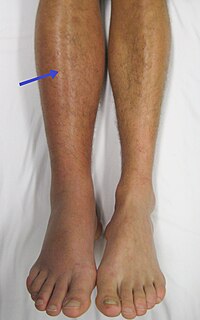
Photo from wikipedia
OBJECTIVE To analyze the clinical characteristics and outcomes of critically ill pregnant and parturient women in intensive care unit (ICU), and to provide clinical experience for the subspecialty construction of… Click to show full abstract
OBJECTIVE To analyze the clinical characteristics and outcomes of critically ill pregnant and parturient women in intensive care unit (ICU), and to provide clinical experience for the subspecialty construction of critical obstetrics. METHODS The clinical data of critically ill pregnant and parturient women admitted to the department of critical care medicine, the Second Affiliated Hospital of Kunming Medical University from January 2011 to December 2019 were collected. The main reasons for maternal transfer to ICU, the causes of maternal death, and organ support measures, etc. were summarized. RESULTS A total of 39 567 critically ill pregnant and parturient women were admitted to the department of obstetrics in our hospital, and 360 were transferred to ICU, with an average ICU transfer rate of 0.91%. Since 2016, the number of obstetric admissions, the number of ICU transfers and the ICU transfer rate had increased significantly. The average age of severe maternals admitted to ICU was (30.9±5.7) years old. The average acute physiology and chronic health evaluation II (APACHE II) score was 7 (4, 10). The average length of ICU stay was 1 (1, 2) day. The average ventilator duration was 9.0 (3.0, 17.5) hours. The main delivery mode of pregnant women in ICU was cesarean section (84.72%). Forty-eight patients (13.33%) underwent hysterectomy, of which 42 (87.5%) due to postpartum hemorrhage. The top 3 causes of ICU admission were severe postpartum hemorrhage [36.94% (133/360)], hypertensive disorders of pregnancy [21.67% (78/360)], pregnancy with cardiac disease [15.00% (54/360)]. The leading cause of postpartum hemorrhage in women transferred to ICU was placental abnormality [63.98% (103/161)], followed by uterine atony [28.57% (46/161)]. The average blood loss was (4 019±2 327) mL within 24 hours after delivery, and the number of women who underwent hysterectomy due to postpartum hemorrhage decreased year by year. During the study period, there were 2 maternal deaths, which were indirect obstetric deaths, 3 cases were discharged against-advice (expected death), including 1 indirect death and 2 direct obstetric death; the mortality in ICU was 1.39% (5/360). CONCLUSIONS The most common reasons for pregnant and parturient women to be admitted to ICU were severe postpartum hemorrhage and hypertensive disorders of pregnancy. The leading cause of postpartum hemorrhage was placental problem. Indirect obstetric deaths exceeded direct obstetric deaths, mainly due to pregnancy complicated with cardiac disease and severe pneumonia. ICU has become an important battlefield for rescuing critically ill maternal and an important guarantee for reducing the maternal mortality.
Journal Title: Zhonghua wei zhong bing ji jiu yi xue
Year Published: 2022
Link to full text (if available)
Share on Social Media: Sign Up to like & get
recommendations!